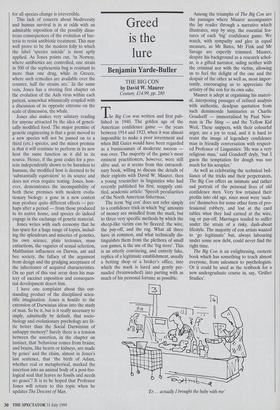Greed is the lure
Benjamin Yarde-Buller
THE BIG CON by David W. Maurer Century, £14.99, pp. 280 The Big Con was written and first pub- lished in 1940. The golden age of the American confidence game — the years between 1914 and 1923, when it was almost impossible to make a poor investment and when Bill Gates would have been regarded as a businessman of moderate success was over. The majority of the game's most eminent practitioners, however, were still alive and, so it seems from this extraordi- nary book, willing to discuss the details of their exploits with David W. Maurer, then a young researcher in linguistics who had recently published his first, snappily enti- tled, academic article: 'Speech peculiarities of the North American fisherman.'
The term 'big con' does not refer simply to a confidence trick in which 'big' amounts of money are swindled from the mark, but to three very specific methods by which the sheep-like victim can be fleeced: the wire, the pay-off, and the rag. What all three have in common, and what technically dis- tinguishes them from the plethora of small con games, is the use of the 'big store'. This is an utterly convincing, and entirely fake, replica of a legitimate establishment, usually a betting shop or a broker's office, into which the mark is lured and gently per- suaded (brainwashed) into parting with as much of his personal fortune as possible. Among the triumphs of The Big Con are the passages where Maurer accompanies the lay reader through a narrative which illustrates, step by step, the essential fea- tures of each 'big' confidence game. We watch, with sympathy and glee in equal measure, as Mr Bates, Mr Fink and Mr Savage are expertly trimmed. Maurer, despite his background as a research schol- ar, is a gifted narrator, siding neither with the criminal nor with the victim, allowing us to feel the delight of the one and the despair of the other as well as, most impor- tantly, encouraging us to appreciate the artistry of the con for its own sake.
Maurer is adept at organising his materi- al, interposing passages of refined analysis with authentic, deadpan quotation from such demimonde luminaries as Charlie Gondorff — immortalised by Paul New- man in The Sting — and the Yellow Kid Well. These snippets, with their colourful argot, are a joy to read, and it is hard to resist the image of legendary confidence man in friendly conversation with respect- ed Professor of Linguistics: 'He was a very religioui man,' said Gondorff dryly, 'but I guess the temptation for dough was too much for his scruples.'
As well as celebrating the technical bril- liance of the tricks and their perpetrators, The Big Con offers an intimate and rather sad portrait of the personal lives of old confidence men. Very few retained their profits into old age, since most were 'suck- ers' themselves for some other form of pro- fessional robbery, and lost at the card tables what they had earned at the wire, rag or pay-off. Marriages tended to suffer under the strain of a risky, dash-about lifestyle. The majority of con artists wanted to 'go legitimate' but, always labouring under some new debt, could never find the right time.
The Big Con is an enlightening, esoteric book which has something to teach almost everyone, from salesmen to psychologists. Or it could be used as the textbook for a new undergraduate course in, say, `Grifter Studies'.
`Er. . . actually I brought the baby with me'


























































 Previous page
Previous page